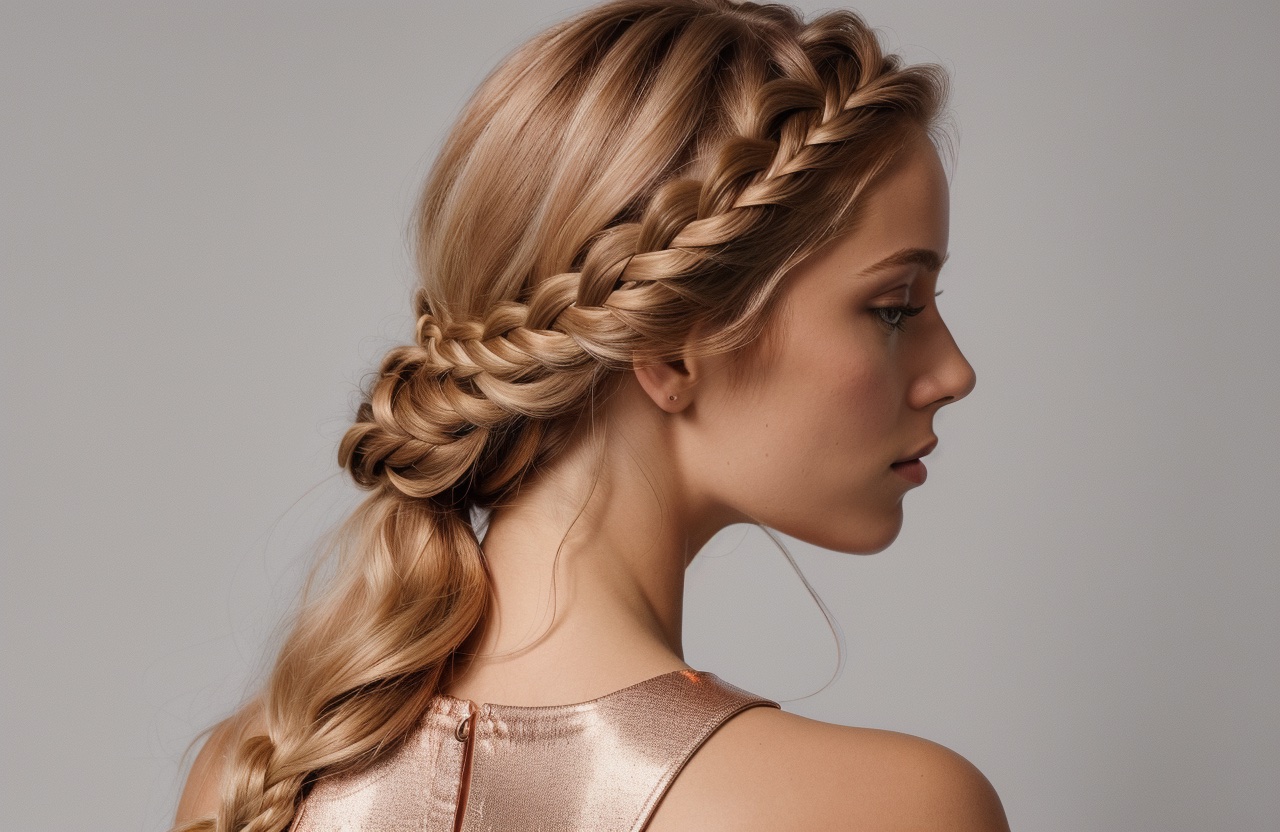Three strand braids are a classic hairstyle that never goes out of fashion. This simple yet versatile technique involves weaving three sections of hair together to create a beautiful, textured look. It’s a fundamental skill that forms the basis for many more complex braiding styles.
Learning to braid can be a game-changer for your hair routine. It’s a practical way to keep your hair neat and tidy, especially on busy days or during workouts. Braids also offer a protective style that can help reduce hair damage from environmental factors and daily styling. Plus, they’re a great option for creating elegant updos or casual, bohemian looks.
Women of all ages and hair types can benefit from mastering the three strand braid. Whether you’re a mom looking to style your daughter’s hair, a professional wanting a quick and polished look, or someone who loves experimenting with different hairstyles, this technique is for you. In the following sections, we’ll cover everything you need to know about creating the perfect three strand braid, from the tools you’ll need to common mistakes to avoid. Let’s get started!
- What tools do you need for a three strand braid?
- How do you prepare your hair for braiding?
- What are the basic steps of a three strand braid?
- How can you make your braid look neater?
- What are some common mistakes to avoid?
- Mastering the Art of Three Strand Braids: Your Path to Perfection
- Frequently Asked Questions
What tools do you need for a three strand braid?
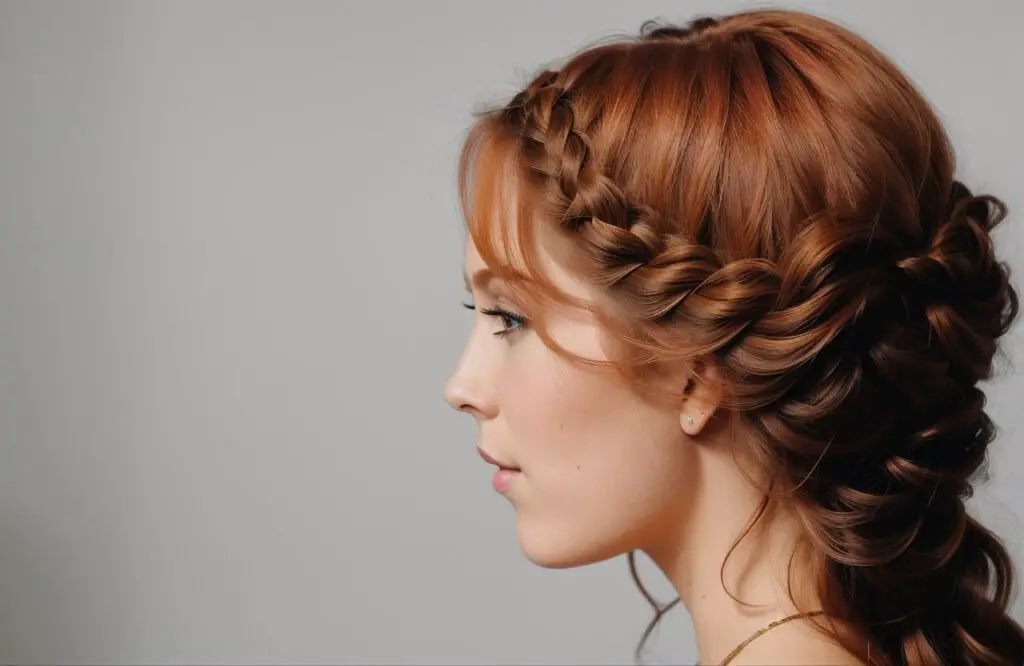
Creating a three strand braid doesn’t require a lot of fancy equipment. In fact, you probably already have most of the tools you need right in your bathroom. Let’s explore the essential and optional items that can help you achieve a perfect braid.
Hair brush or comb
The foundation of any good braid starts with well-detangled hair. A brush or comb is crucial for this step. But which one should you choose? It depends on your hair type and personal preference.
A wide-toothed comb works well for most hair types, especially if you have thick or curly hair. It’s gentle on your strands and helps prevent breakage. For finer hair, a paddle brush might be more effective at smoothing out tangles.
Remember to be gentle when detangling. Start from the ends of your hair and work your way up to the roots. This technique minimizes damage and makes the process less painful.
Hair ties or elastics
Once you’ve finished your braid, you’ll need something to secure it. This is where hair ties or elastics come in handy. But not all hair ties are created equal.
Seamless elastics are a popular choice because they don’t snag or damage your hair. They come in various sizes and colors, so you can choose one that matches your hair or adds a fun pop of color.
If you have thick hair, you might prefer fabric-covered elastics. These tend to be stronger and can hold more hair without slipping.
Here are some tips for choosing the right hair tie:
- Opt for snag-free options to prevent hair damage
- Choose a size appropriate for your hair thickness
- Consider clear elastics for a more invisible finish
- Avoid rubber bands, as they can cause breakage
Optional: hair spray
While not strictly necessary, hair spray can be a useful addition to your braiding toolkit. It helps keep flyaways in check and gives your braid a polished look.
When using hair spray, less is more. A light mist over your finished braid is usually sufficient. If you’re going for a sleeker look, you can spray a small amount on your brush before you start braiding to tame frizz from the beginning.
Optional: hair clips
Hair clips can be incredibly helpful, especially if you’re new to braiding. They allow you to section off your hair, making it easier to manage as you braid.
Small, alligator-style clips work well for this purpose. They’re strong enough to hold sections of hair in place but won’t leave noticeable marks.
You can also use clips to pin back any shorter layers or bangs that might not reach your braid. This helps create a neater overall look.
Optional: leave-in conditioner
If your hair tends to be dry or frizzy, a leave-in conditioner can be a game-changer. It helps smooth your hair, making it easier to braid and reducing the likelihood of flyaways.
Apply a small amount of leave-in conditioner to damp hair before you start braiding. Focus on the ends of your hair, which tend to be drier. This will not only make your braid look better but also help keep your hair healthy.
With these tools at your disposal, you’re well-equipped to create beautiful three strand braids. Remember, practice makes perfect. Don’t get discouraged if your first attempts aren’t flawless. Keep trying, and soon you’ll be braiding like a pro!
How do you prepare your hair for braiding?
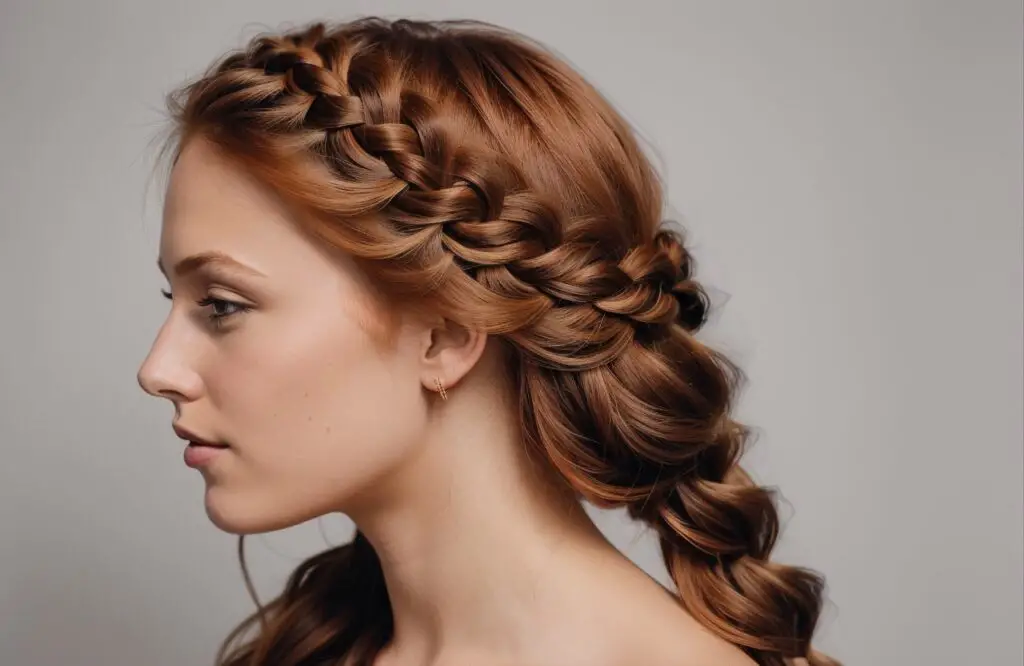
Preparing your hair for braiding is a crucial step that can make or break your final look. With the right techniques, you’ll create a smooth, polished braid that stays in place all day. Let’s explore the essential steps to get your hair ready for braiding.
Detangling techniques
The first step in preparing your hair for braiding is to remove any knots or tangles. This process requires patience and gentle handling to avoid damaging your hair. Start by using a wide-toothed comb or a detangling brush, working from the ends of your hair up towards the roots. This method prevents you from pulling on knots and potentially breaking your hair.
For particularly stubborn tangles, try using your fingers first. Gently separate the strands, then follow up with your comb or brush. If you encounter a tough knot, hold the section of hair above it to prevent pulling at your scalp.
Some women find it helpful to detangle their hair in the shower while applying conditioner. The slippery texture can make it easier to work through knots. Just be sure to use a wide-toothed comb designed for wet hair to minimize breakage.
Moisturizing tips
Well-moisturized hair is easier to braid and less prone to frizz and flyaways. How you moisturize will depend on your hair type and personal preferences. Here are some options to consider:
- Leave-in conditioner: Apply a small amount to damp hair, focusing on the ends.
- Hair oil: A few drops can add shine and tame frizz. Be careful not to use too much, as it can make your hair greasy.
- Moisturizing cream: This works well for thicker or curlier hair types.
- Water: Sometimes, a light misting of water is all you need to refresh your hair before braiding.
Choose a product that works well with your hair type and doesn’t leave a heavy residue. You want your hair to be moisturized but not weighed down.
Sectioning the hair
Once your hair is detangled and moisturized, it’s time to section it. This step makes the braiding process much more manageable, especially if you have thick or long hair.
Start by parting your hair where you want your braid to begin. For a classic three-strand braid, this is usually down the middle of your head. Use the pointed end of a comb to create a clean, straight part.
Next, divide your hair into three equal sections. If you’re new to braiding, you might find it helpful to use hair ties to keep these sections separate until you’re ready to start braiding.
Securing the top section
The top section of your braid is crucial for creating a neat, polished look. To keep it secure, try this technique: Take a small section of hair from the front of your head, about an inch wide. Divide this section into three parts and begin your braid.
As you braid, gradually incorporate more hair from the sides into each section. This technique, known as a French braid, helps to keep the top of your braid neat and prevents loose strands from escaping.
If you’re not comfortable with French braiding, you can simply secure the top section with a small elastic before you start your main braid. This will help keep everything in place.
Smoothing the hair
The final step in preparing your hair for braiding is smoothing it out. This helps create a sleek, polished look and reduces frizz and flyaways.
One effective method is to use a boar bristle brush. These brushes are great for distributing your hair’s natural oils from root to tip, which helps smooth the hair shaft. Brush your hair in the direction you’ll be braiding it.
For extra smoothness, you can apply a small amount of hair gel or pomade to your hands and lightly run them over your hair. Focus on the areas around your face and the top of your head, as these are most prone to flyaways.
If you have curly or textured hair, you might prefer to use a smoothing cream or leave-in conditioner instead of gel. Apply it to damp hair and use a wide-toothed comb to distribute it evenly.
By following these preparation steps, you’ll set yourself up for braiding success. Your hair will be easier to work with, and the resulting braid will look neater and last longer. Happy braiding!
What are the basic steps of a three strand braid?

Creating a three strand braid might seem tricky at first, but with practice, it becomes second nature. Let’s break down the process into simple, easy-to-follow steps.
Dividing hair into three sections
Start by gathering all your hair at the nape of your neck. Run your fingers through it to smooth out any tangles. Now, split your hair into three equal sections. Hold the right section in your right hand, the left section in your left hand, and the middle section between your thumb and forefinger of either hand.
How do you know if your sections are even? A quick glance in the mirror can help. If one section looks significantly larger than the others, adjust accordingly. Remember, practice makes perfect, so don’t worry if it’s not exactly even the first few times.
Understanding the over-under pattern
The key to a three strand braid lies in the over-under pattern. Think of it as a dance where each section takes turns moving to the center. The outer sections alternately cross over the middle, becoming the new middle section.
Visualize it this way:
- Right section goes over the middle
- Left section goes over the new middle
- Repeat
This pattern creates the classic braid look we all know and love. Once you get the hang of this rhythm, you’ll find your fingers moving almost automatically.
Maintaining tension while braiding
Tension is crucial for a neat, long-lasting braid. But what does “tension” mean in braiding? It’s the amount of pull you apply to the hair as you work. Too little tension, and your braid will be loose and messy. Too much, and it might be uncomfortable or cause breakage.
To find the right balance, start with a gentle pull. As you braid, keep the sections taut but not stretched. Your braid should feel secure but not painful. If you have fine or delicate hair, err on the side of less tension to avoid damage.
Crossing right section over middle
Now, let’s get into the actual braiding. Take the right section and cross it over the middle section. This right section now becomes your new middle. The original middle section is now on the right.
A common mistake is losing track of which section is which. To avoid confusion, try this mental trick: always think of the sections by their current position (right, middle, left) rather than where they started.
Crossing left section over new middle
After moving the right section, it’s the left section’s turn. Cross the left section over the new middle (which was originally the right section). The left section now becomes the middle, and the previous middle moves to the left.
Continue this pattern all the way down your hair. Right over middle, then left over middle. As you work, you’ll see the braid taking shape.
Here’s a tip: try saying “right, left, right, left” as you braid. This verbal cue can help you maintain the rhythm and avoid mixing up the sections.
As you near the end of your hair, you might notice the sections becoming smaller and harder to manage. Don’t worry – this is normal. Keep braiding until you reach the very ends of your hair, or until the remaining hair is too short to continue braiding.
Once you’ve reached the end, secure your braid with an elastic band. Make sure it’s tight enough to hold the braid in place, but not so tight that it puts stress on your hair.
For a polished look, you can gently tug on the edges of your braid to loosen it slightly. This technique, often called “pancaking,” gives your braid a fuller, more relaxed appearance.
Remember, braiding is a skill that improves with practice. If your first attempts don’t look perfect, don’t get discouraged. Keep trying, and soon you’ll be creating beautiful three strand braids with ease.
How can you make your braid look neater?
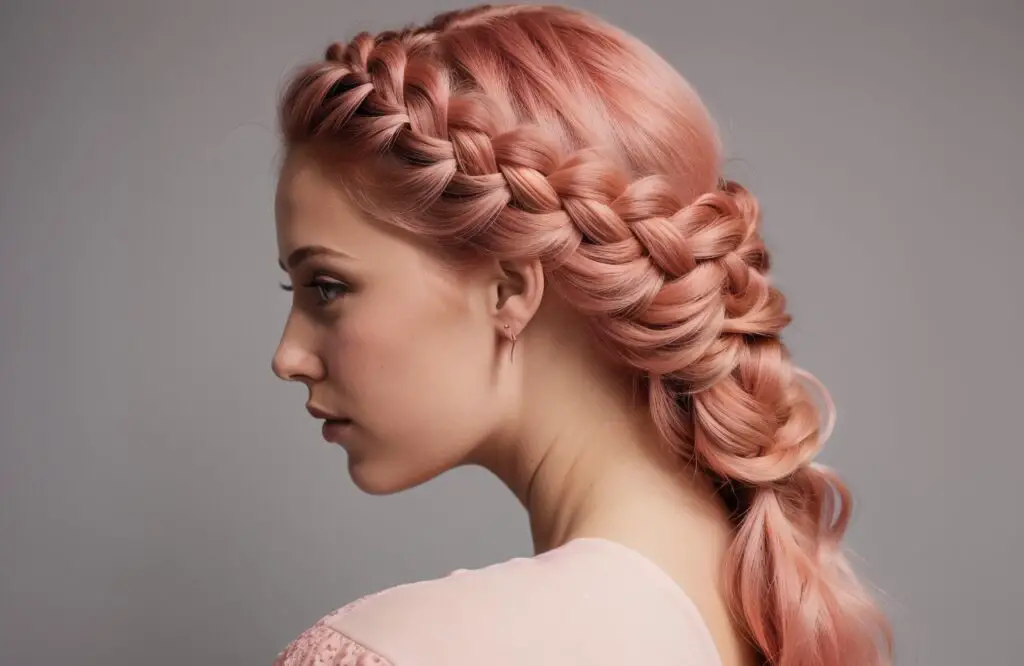
A neat braid can elevate your entire look, making you appear polished and put-together. Let’s explore some techniques to refine your braiding skills and create a sleek, professional-looking result.
Starting with damp hair
Have you ever noticed how your hair behaves differently when it’s slightly damp? This moisture can be a game-changer for your braid. Lightly misting your hair with water or a leave-in conditioner can make it more manageable and easier to style.
Why does this work? Damp hair is more pliable and less likely to fly away or create frizz. It also tends to hold its shape better as it dries, resulting in a neater final look.
However, be cautious not to start with soaking wet hair. Too much moisture can make your braid look stringy and take forever to dry. Aim for hair that feels cool to the touch but doesn’t drip water.
Using a mirror for better visibility
Braiding without being able to see what you’re doing can be challenging. A mirror (or two) can significantly improve your technique. Position yourself in front of a large mirror, and if possible, use a handheld mirror to check the back of your head.
This setup allows you to see your braid from different angles, helping you maintain evenness and catch any stray hairs. It’s particularly useful when you’re learning to braid or trying a new style.
Try this: practice braiding in front of a mirror, paying attention to how your hands move. Over time, you’ll develop muscle memory that will make braiding easier, even without a mirror.
Keeping sections even
Consistent section sizes are key to a neat braid. Uneven sections can result in a lopsided or messy appearance. But how do you keep your sections even throughout the braiding process?
Start by dividing your hair into three equal parts. As you braid, pay attention to the thickness of each section. If one starts to look thinner or thicker than the others, adjust accordingly by adding or removing a bit of hair.
A helpful tip is to use your fingers as a guide. Try to maintain the same amount of hair between your fingers for each section as you braid.
Braiding at an angle
The angle at which you braid can significantly impact the neatness of your result. Braiding straight down can sometimes lead to a flat, lifeless look. Instead, try braiding at a slight downward angle.
To do this, tilt your head slightly to one side as you braid. This creates a more natural fall for your hair and can help prevent the braid from looking too tight or severe.
Experiment with different angles to find what works best for your hair type and desired look. You might be surprised at how this small adjustment can transform your braid.
Smoothing as you go
Smoothing your hair as you braid is crucial for a polished finish. This technique helps to tame flyaways and incorporate any stray hairs into your braid.
Here are some smoothing strategies to try:
- Use a fine-toothed comb to smooth each section before incorporating it into the braid
- Run your fingers over each section to catch any loose strands
- Apply a small amount of hair oil or smoothing cream to your hands and lightly run them over your hair as you braid
- Keep a small brush nearby to tame any stubborn flyaways
Remember, the goal is to create a smooth surface without making your braid look too “perfect” or unnatural.
Incorporating these techniques into your braiding routine can help you achieve a neater, more polished result. However, don’t get discouraged if your braid doesn’t look flawless right away. Like any skill, braiding improves with practice.
Try setting aside a few minutes each day to practice your braiding technique. Pay attention to how different factors – like the dampness of your hair, the angle of your braid, and your smoothing technique – affect the final result.
With time and patience, you’ll find yourself creating neater, more professional-looking braids. And who knows? You might even discover a few personal tricks along the way that work especially well for your hair type and style preferences.
What are some common mistakes to avoid?
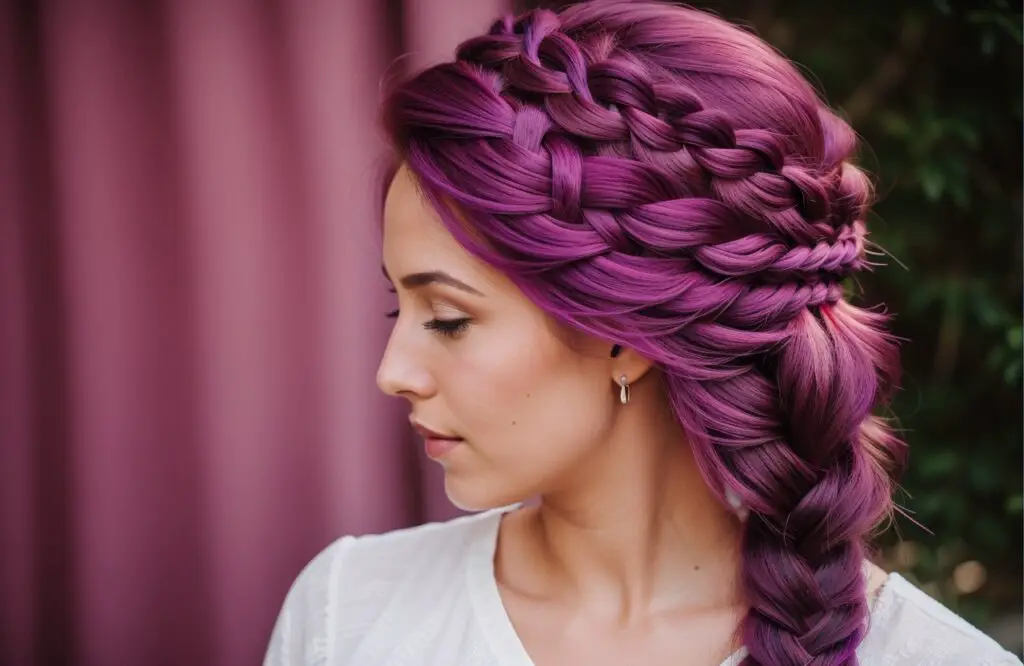
Mastering the art of three strand braiding takes practice, and along the way, you might encounter a few hiccups. Let’s explore some common pitfalls and how to sidestep them for a flawless braid every time.
Braiding too tightly
You might think that a tight braid equals a neat braid, but that’s not always the case. Overly tight braids can cause discomfort and even damage to your hair and scalp. How tight is too tight? If you feel a constant pulling sensation or see little bumps forming along your hairline, you’ve likely crossed that line.
To avoid this, try loosening your grip as you braid. Your hair should feel secure but not strained. A good rule of thumb: if you can’t move your eyebrows freely, your braid is too tight.
Inconsistent tension
On the flip side of braiding too tightly, inconsistent tension can lead to a messy, uneven braid. Maintaining consistent tension throughout the braiding process is crucial for a polished look. Think of it like strumming a guitar – you want each string (or in this case, strand) to have the same amount of tension.
How can you achieve this? Practice makes perfect, but here’s a tip to start: use your fingers as a guide. Try to maintain the same amount of space between your fingers as you braid each section. This can help you keep the tension even throughout.
Uneven sections
Uneven sections can make your braid look lopsided or messy. It’s a common mistake, especially when you’re just starting out. But don’t worry, there’s a simple fix.
Start by dividing your hair into three equal parts before you begin braiding. As you work, periodically check that each section remains roughly the same size. If one section starts to look thinner or thicker than the others, adjust by adding or removing a bit of hair.
Here’s a pro tip: use a comb to section your hair at the start. This can help you create more precise divisions.
Losing grip on strands
Losing your grip on the strands while braiding can lead to a messy result and make the process more difficult. It’s especially common if you have fine or slippery hair. So, how can you maintain a good grip?
Try these techniques:
- Use a texturizing spray to add some grip to your hair
- If your hands tend to get sweaty, keep a small towel nearby to dry them
- Practice braiding with slightly damp hair, which can be easier to grip
- Consider using hair elastics to secure each section at the start
Remember, a secure grip doesn’t mean a death grip. You want to hold the hair firmly but gently.
Rushing the process
In our fast-paced world, it’s tempting to rush through your hair routine. But when it comes to braiding, slow and steady wins the race. Rushing can lead to mistakes like uneven sections, loose strands, or a generally messy appearance.
Take your time, especially when you’re learning. Focus on each step of the process. Are your sections even? Is your tension consistent? Are you incorporating all the hair as you go?
If you find yourself short on time in the mornings, consider braiding your hair the night before. Not only will this give you more time to create a neat braid, but it can also result in beautiful waves when you take it out the next day.
By avoiding these common mistakes, you’ll be well on your way to creating beautiful, neat braids. Remember, everyone’s hair is different, so what works for one person might not work for another. Don’t be afraid to experiment and find the techniques that work best for you and your hair type.
Braiding is a skill that improves with practice. So, if your first attempts don’t turn out perfectly, don’t get discouraged. Keep at it, and soon you’ll be braiding like a pro. Your patience and persistence will pay off with gorgeous, head-turning braids that stay put all day long.
Mastering the Art of Three Strand Braids: Your Path to Perfection
Creating beautiful three strand braids is a skill that combines technique, patience, and practice. By understanding the basic steps, preparing your hair properly, and avoiding common pitfalls, you can elevate your braiding game to new heights. Remember to start with well-detangled hair, maintain consistent tension, and take your time throughout the process. These simple yet effective strategies will help you achieve neat, long-lasting braids that look professionally done.
As you continue to refine your braiding skills, don’t be afraid to experiment with different techniques and styles. Every woman’s hair is unique, so what works best for you might be slightly different from what works for others. Embrace the learning process, celebrate your progress, and enjoy the versatility that braiding brings to your hairstyling repertoire. With dedication and practice, you’ll soon find yourself creating stunning braids that turn heads and boost your confidence.
Frequently Asked Questions
Q: What are the basic steps of a three strand braid?
A: Divide hair into three equal sections, cross the right section over the middle, then the left section over the new middle, and repeat this pattern until you reach the end of your hair.
Q: How can I make my braid look neater?
A: Start with damp hair, use a mirror for better visibility, keep sections even, braid at a slight angle, and smooth your hair as you go.
Q: Why is it important to avoid braiding too tightly?
A: Braiding too tightly can cause discomfort and damage to your hair and scalp. A good braid should feel secure but not strained.
Q: How can I maintain consistent tension while braiding?
A: Use your fingers as a guide, trying to maintain the same amount of space between them as you braid each section.
Q: What should I do if I keep losing grip on the strands while braiding?
A: Try using a texturizing spray, keep your hands dry, practice with slightly damp hair, or use hair elastics to secure each section at the start.
Q: Is it better to braid quickly or slowly?
A: It’s better to braid slowly, especially when learning. Taking your time allows you to focus on creating even sections and maintaining consistent tension.
Q: How can I prepare my hair for braiding?
A: Detangle your hair thoroughly, apply a leave-in conditioner or light moisturizer, and section your hair evenly before you start braiding.
Q: Can I braid my hair when it’s wet?
A: It’s best to braid slightly damp hair rather than wet hair. Damp hair is more manageable, while wet hair can lead to a stringy look and take too long to dry.

